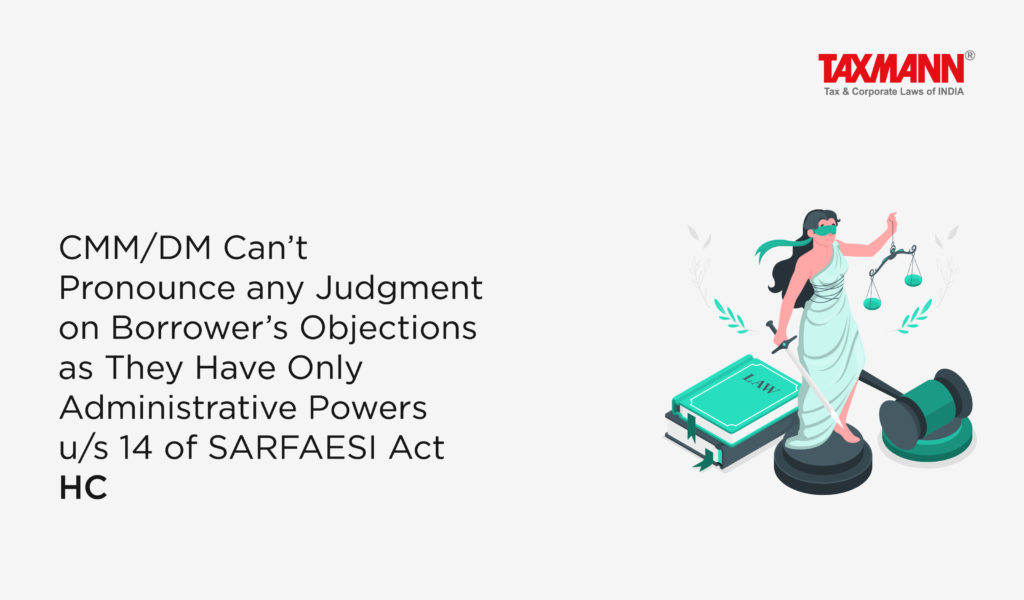CMM/DM Can’t Pronounce any Judgment on Borrower’s Objections as They Have Only Administrative Powers u/s 14 of SARFAESI Act | HC
- Blog|News|FEMA & Banking|
- 3 Min Read
- By Taxmann
- |
- Last Updated on 28 August, 2023

Case Details: L&T Finance Ltd. v. State of Maharashtra - [2023] 153 taxmann.com 34 (HC-Bombay)
Judiciary and Counsel Details
-
- Nitin Jamdar & Abhay Ahuja , JJ.
- S.S. Panchpor, S.S. Agave & Ms Asha Bhuta for the Petitioner.
- Dr. Birendra Saraf, Adv. General, P.P. Kakade, Govt. Pleader, Ms Shruti D. Vyas, B. Panel Counsel, S.R. Nargolkar, Himanshu Takke AGP & Graham Francis for the Respondent.
Facts of the Case
In the instant case, petitions were filed by the secured creditors who had applied under section 14 of the SARFAESI Act, 2002. Since the applications have not been disposed of, the petitioners have filed these petitions for directions for the early disposal of these petitions.
The petitioners shared a common grievance that despite the ministerial power granted under section 14, meant to assist secured creditors in efficiently recovering their dues, their applications were unreasonably delayed.
Taking cognizance of the grievance, on the earlier dates, the State Government was called upon to place data of the pending applications filed under section 14 before various District Magistrates.
The High Court observed that the powers of Chief Metropolitan Magistrate or District Magistrate (CMM/DM) under section 14 are merely administrative and do not involve pronouncing any judgment on the borrower’s objections to a secured creditor taking possession of secured assets.
Further, once the secured creditor has met all requirements under section 14, it is the duty of CMM/DM to assist the secured creditor in obtaining possession of assets and related documents, with the help of any subordinate officer or appointed Advocate Commissioner.
The High Court, further observed that the application filed by a secured creditor under section 14 with due compliance should be disposed of by CMM/DM not later than 30 days of the application is filed. The same option can also be considered by the Judicial Magistrate, if so permissible in law.
High Court Held
The High Court held that any party whose application is not disposed of within sixty days of its filing or whose order has not been implemented within sixty days of passing it, may make representation to the Divisional Commissioner.
The Divisional Commissioner, shall within 15 days of receipt of representation consider the representation and after satisfying that there is no justifiable reason, will pass appropriate directions to ensure that the application is disposed of or order is implemented within fifteen days of direction.
The High Court, further held that the State Government would take steps to implement an e-system placing information on an online platform regarding applications, such as the date of filing of the application, the date of passing the order on the application, and the date of implementation of the order, on an online platform.
List of Cases Reviewed
-
- NKGSB Coop. Bank Ltd. v. Subir Chakravarty [2022] 10 SCC 286 (para 7)
- Balkrishna Rama Tarle v. Phoenix ARC (P.) Ltd. [2022] 142 taxmann.com 492/174 SCL 534 (SC) (para 8) followed.
List of Cases Referred to
-
- NKGSB Coop. Bank Ltd. v. Subir Chakravarty [2022] 10 SCC 286 (para 7)
- R.D. Jain & Co. v. Capital First Ltd. [2022] 140 taxmann.com 614/173 SCL 533 (SC)/[2023] 1 SCC 675 (para 7)
- Balkrishna Rama Tarle v. Phoenix ARC (P.) Ltd. [2022] 142 taxmann.com 492/174 SCL 534 (SC) (para 7)
- International Asset Reconstruction Company (P.) Ltd. v. Union of India AIR 2011 Bom. 163 (para 10).
Disclaimer: The content/information published on the website is only for general information of the user and shall not be construed as legal advice. While the Taxmann has exercised reasonable efforts to ensure the veracity of information/content published, Taxmann shall be under no liability in any manner whatsoever for incorrect information, if any.

Taxmann Publications has a dedicated in-house Research & Editorial Team. This team consists of a team of Chartered Accountants, Company Secretaries, and Lawyers. This team works under the guidance and supervision of editor-in-chief Mr Rakesh Bhargava.
The Research and Editorial Team is responsible for developing reliable and accurate content for the readers. The team follows the six-sigma approach to achieve the benchmark of zero error in its publications and research platforms. The team ensures that the following publication guidelines are thoroughly followed while developing the content:
- The statutory material is obtained only from the authorized and reliable sources
- All the latest developments in the judicial and legislative fields are covered
- Prepare the analytical write-ups on current, controversial, and important issues to help the readers to understand the concept and its implications
- Every content published by Taxmann is complete, accurate and lucid
- All evidence-based statements are supported with proper reference to Section, Circular No., Notification No. or citations
- The golden rules of grammar, style and consistency are thoroughly followed
- Font and size that’s easy to read and remain consistent across all imprint and digital publications are applied





